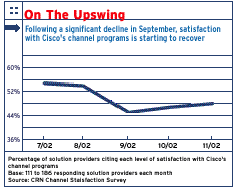Cisco-Certified Ranks Halved
The number of certified Cisco partners dropped to about 3,000 worldwide at the end of October from some 6,000, said Paul Mountford, vice president of worldwide channels at the networking hardware vendor. "In the [United States, we now have 1,000 [certified partners going after $9 billion in business instead of 2,200 [partners," he said.

\
PAUL MOUNTFORD
'It was designed to emphasize the value model. . . It has divided the men from the boys.' -- Paul Mountford, Cisco Systems
Cisco recertifies all of its partners each October, and many decided not to recertify under the vendor's more stringent requirements, he said.
Under Cisco's revised channel program, introduced in March 2001, all certified partners are required to have achieved at least one technology specialization by this year's recertification period, he said.
The bulk of partners dropping out came from Cisco's Premier partner ranks. Cisco's Gold and Silver partners already were required to have specializations in place.
Cisco solution providers opting out of the certification program still will be able to buy many Cisco products through two-tier distribution; however, certified partners receive higher discounts and have access to more emerging product lines, he said.
Mountford told CRN that he knew the new requirements would reduce the number of Cisco partners, but "the program wasn't designed to eliminate a certain number of partners," he said. "It was designed to emphasize the value model."

As a result, the new requirements have "divided the people who want to invest in partnering with Cisco from those who don't," Mountford added. "It has divided the men from the boys."
Many Cisco solution providers have long complained that Cisco had certified too many partners without distinguishing between those that invest in technological expertise and those that only fulfill product.
Chris Vincent, vice president of sales and marketing at Global Data Systems, an enterprise solution provider in Lafayette, La., said he is already seeing a difference. On any deal, two or three solution providers would compete for the business with a solutions approach, and seven or eight "ankle-biters" would try to do product fulfillment with deep discounting, Vincent said. Since October, however, "I'm seeing a lot fewer ankle-biters trying to play in these deals," he said.
During the dot-com era, "everybody in the world became a Cisco partner, and Cisco became very overdistributed. That had a lot to do with the price and margin erosion," said John Freres, president of Meridian IT Solutions, Schaumburg, Ill. "Now that Cisco has raised the bar, it's going to allow those of us who have made the commitment to make more money."
Rick Rubenstein, president of RMS Business Systems, Buffalo Grove, Ill., said, "Cisco built its channel program during the tornado, and we're not in a tornado anymore."
With the reduced partner count, Cisco may need to recruit more solution providers for specific technology areas but will fill in the gaps with existing partners first, Mountford said.